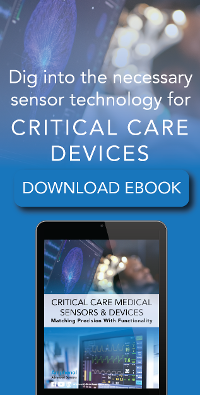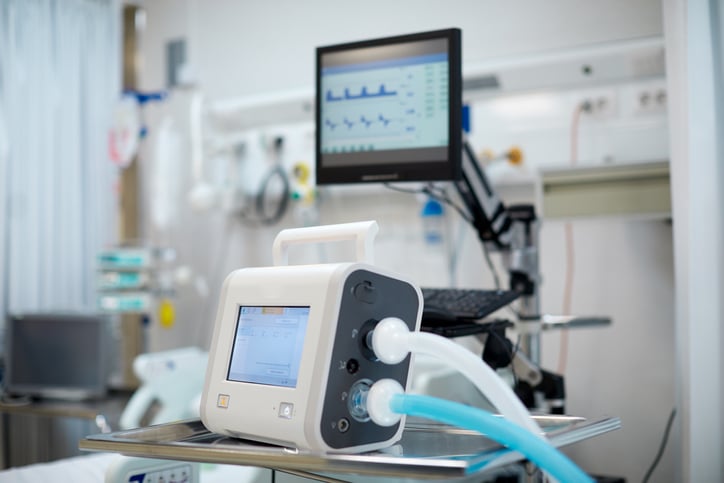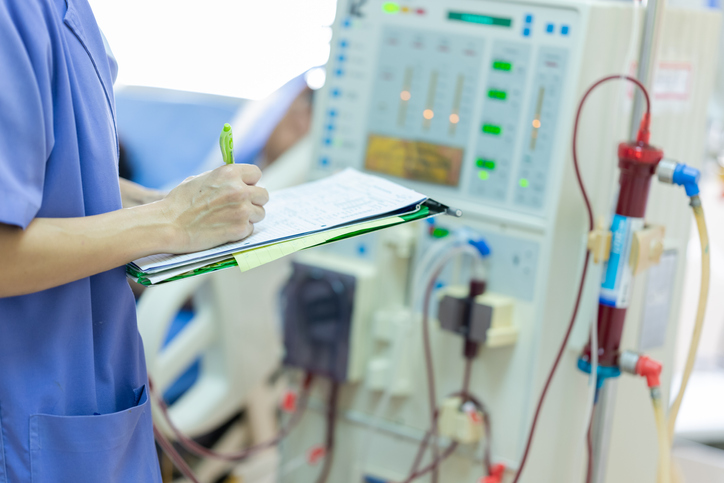Custom Miniature Sensors in Critical Care | The Rising Demand for Precision

Look at nearly any device on the market today, and chances are, it's smaller than it was a decade ago.
A reason for that – custom miniature sensors.
This shift toward smaller, more efficient technology isn’t just happening in consumer electronics – it’s transforming critical care devices as well.
The downsizing of medical technology is reshaping patient treatment. More streamlined and sophisticated, compact medical devices are giving healthcare professionals new ways to provide high-quality care.
But these advancements wouldn’t be possible without custom miniature sensors – precision-engineered components designed to fit not just the device, but the demanding conditions of critical care settings.
How Custom Miniature Sensors Support Critical Care Devices
Small, specialized monitoring devices that measure and track vital patient metrics, miniature sensors are scaling down their predecessors without compromising accuracy or functionality.
While the miniaturizing of medical devices is nothing new in medicine, it's certainly cementing its place in critical care. Smaller devices and accompanying sensors are helping caregivers do more.
The need for miniaturized custom sensors in medicine is being driven by several factors that aren't changing anytime soon:
-
Rapid Advancements in Medical Technology: As medical devices become more compact, the demand for smaller, specialized sensors grows – requiring designs beyond what off-the-shelf alternatives can offer.
-
Increasing Demand for Personalized Patient Care: Patient care has always been personal, but technology now allows doctors to provide more individualized treatments than ever, leading to better outcomes.
-
Real-Time Monitoring: Detailed patient data helps medical professionals provide better care. In critical settings, even small changes in a patient’s condition can have major effects.
5 OEM Medical Devices Using Custom Miniature Sensors for Better Performance
Like miniature medical sensors, OEM medical equipment continues to shrink in size while remaining just as – if not more – impactful in patient care. In fact, they're already well-established in critical care settings and delivering results.
How are custom miniature medical sensors helping to upgrade patient treatment?
Let's look at five devices that benefit from custom miniature medical sensors:
-
Respiratory Monitors
-
Blood Pressure Monitors
-
Temperature Monitoring Devices
-
Cardiac Monitors
-
Intracranial Catheters
1. Respiratory Monitors
Function: Measures a patient's respiratory parameters, including respiratory rate, tidal volume, and oxygen saturation, to detect changes in respiratory function and alert healthcare providers of potential respiratory distress.
Application: Used to monitor patients who require mechanical ventilation or have chronic respiratory conditions to ensure optimal lung function and prevent respiratory failure.
How miniature sensors upgrade the device: Tiny pressure sensors can be placed on the body or near the lungs, providing real-time data that can help medical personnel quickly identify any changes in a patient's condition.
2. Blood Pressure Monitors
Function: Measures a patient's blood pressure to detect changes in cardiovascular function and alert healthcare providers of potential complications.
Application: Used to monitor patients who are critically ill or undergoing surgery to ensure optimal hemodynamic stability and prevent adverse events.
How miniature sensors upgrade the device: Smaller pressure sensors allow the device to detect subtle fluctuations in blood pressure that may not be detected by traditional methods without causing discomfort during long- or short-term use.
3. Temperature Monitoring Devices
 Function: Measuring body temperature helps healthcare providers to detect and treat issues such as infection, inflammation, or organ dysfunction before they become bigger problems.
Function: Measuring body temperature helps healthcare providers to detect and treat issues such as infection, inflammation, or organ dysfunction before they become bigger problems.
Application(s): Covering a wide variety of applications across critical care, temperature sensors are used in devices for cardiac care, laser surgical assemblies, dialysis, and respiratory care.
How miniature sensors upgrade the device(s): Small and lightweight, custom miniature sensors can be placed anywhere on the body, allowing for more accurate readings than larger sensors. In addition, they can be designed for some of the most sophisticated & small medical devices, such as laser surgical assemblies, to bring temperature monitoring where the device is.
4. Cardiac Monitors
Function: Measures a patient's heart rate and rhythm to detect changes in cardiovascular function and alert healthcare providers of potential complications.
Application(s): Another broad category, cardiac monitors are used on patients who are critically ill, undergoing surgery, or have a history of heart disease to ensure optimal cardiac function and prevent adverse events. Cardiac monitors in critical care take several forms, including catheters, fractional flow reserve monitors, and arterial blood pressure devices.
How miniature sensors upgrade the device(s): Miniature sensors enable the integration of cardiac monitors directly onto patients, eliminating cumbersome wires and allowing healthcare providers to measure a patient's cardiovascular activity remotely. Used in surgical procedures, surgical teams have a better & less intrusive way to monitor key metrics and vital signs.
5. Intracranial Catheters
Function: Inserted into the brain, this catheter gives caregivers a means to measure key metrics – pressure and temperature.
Application: Used to monitor patients who are recovering from neurological surgery or have suffered a traumatic brain injury, stroke, or other condition to ensure optimal brain perfusion and prevent secondary brain injury.
How miniature sensors upgrade the device: As one of the most delicate and complex organs, the brain requires precision when it comes to monitoring. Miniaturized sensors help intracranial catheters provide a clearer picture of what's going on in the brain with less risk and better accuracy.
Upgrading Patient Care & Outcomes
Regardless of use, custom miniature sensors in critical care devices help improve patient care and outcomes. For any medical device engineer, the benefits of a miniature sensor designed and manufactured for a specific application:
-
Improved accuracy
-
Non-invasiveness
-
Reduced risk of infection
-
Increased patient comfort
-
Cost-effectiveness
Improved Data
For doctors and nurses treating a patient, there's nothing more important than data that's accurate. Custom miniature sensors provide more precise measurements with less risk of error.
And being designed to the device they're in, custom miniature sensors are more reliable than a sensor that is essentially retrofitted. A custom sensor manufacturer takes into account design considerations such as:
- Size
- Housing
- Environmental factors
- Longevity
Non-Invasiveness
There's a simple reality with smaller sensors – because of their size, they're less intrusive. In delicate procedures and for critical care patients, the less invasive a device is, the better – there's less disruption to the body and a reduced chance for complications.
Reduced Risk for Infection
At any given time, one in every 31 patients in a hospital has a Healthcare-Associated Infection (HAI). Though an infection of any sort is concerning in patient care, HAI's are particularly worrisome for critical care patients as infections can be more impactful on a person's condition and recovery.
Because miniature sensors are less invasive, the risk of infection is greatly reduced because there's less surface area for bacterial growth or disruption to the patient's body.
Increased Patient Comfort
Consider the cell phones of the late 1990s. Comparatively speaking, they were cumbersome and you knew when you were carrying it around. As technology improved, phones became smaller and more sleek.
Custom miniature sensors allow for reducing the need for bulky medical equipment or intrusive procedures. Wearable sensors in healthcare are a prime example of this. Smaller devices and sensor technology make it possible to monitor patient vitals without impeding their mobility or requiring additional hardware.
Cost-Effective Treatment
With better data and a better user experience, delivering high-level, yet specific care that's tailored to the patient is easier. With this comes cost savings both in terms of resources and time.
For example, with custom miniature sensors, IV pumps are able to quickly adjust and regulate flow rates with greater accuracy. With more control over care, healing and recuperation happen faster, saving on both long- and short-term medical costs.
Obstacles in Designing Custom Miniature Sensors for Critical Care
Creating a custom-designed miniature sensor for medical devices isn't as simple as taking an existing sensor schematic and reducing its measurements.
Building smaller requires a high level of expertise and experience – something not all OEM sensor manufacturers have.
On the technical side, creating a smaller sensor that meets and exceeds performance requirements means designing it so that – aside from size – there's virtually no difference from a standard-sized sensor without compromising:
-
Accuracy
-
Reliability
-
Lifespan
Not all custom sensors are created for brand-new medical devices. In these instances, the miniature sensor is essentially being retrofitted to the application. This kind of integration isn't always simple. That's not to say it's impossible, either.
Take pressure sensors, for instance. In a perfect world, adding a custom sensor would be as simple as removing the old component and plugging in the new one. However, pressure sensors have their own unique footprint in a device, and a custom medical instrument design and development (regardless of size) must accommodate this.
Like all components of a medical device, custom miniature sensors have to meet regulatory compliance measures for both performance and safety. For critical care applications, these standards are even more stringent. Remember: all it takes is one part of a device not meeting standards to render it out of compliance.
A Big Future for Custom Miniature Medical Sensors
The shift toward custom miniature sensors is reshaping patient care, enabling smaller medical devices to support more advanced treatments. As medical technology evolves, these precision-engineered sensors will continue to be a driving force behind innovations in critical care devices.
With their ability to provide accurate, real-time data in compact designs, they are set to play an even greater role in the future of medical device design.
Smaller Sensors, Smarter Solutions – Talk to an Engineer Today
Speak with one of our engineers today:




